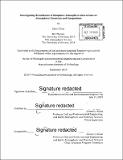| dc.contributor.advisor | Colette L. Heald. | en_US |
| dc.contributor.author | Silva, Sam J.(Sam James) | en_US |
| dc.contributor.other | Massachusetts Institute of Technology. Department of Civil and Environmental Engineering. | en_US |
| dc.date.accessioned | 2020-03-23T18:10:37Z | |
| dc.date.available | 2020-03-23T18:10:37Z | |
| dc.date.copyright | 2019 | en_US |
| dc.date.issued | 2019 | en_US |
| dc.identifier.uri | https://hdl.handle.net/1721.1/124187 | |
| dc.description | Thesis: Ph. D., Massachusetts Institute of Technology, Department of Civil and Environmental Engineering, 2019 | en_US |
| dc.description | Cataloged from PDF version of thesis. | en_US |
| dc.description | Includes bibliographical references (pages 169-191). | en_US |
| dc.description.abstract | The interactions between the biosphere and the atmosphere are an important controlling factor for regional to global atmospheric chemistry and composition. This ultimately has wide impacts on issues like air quality and climate change. However, there are still substantial uncertainties in the biosphere-atmosphere interaction processes that drive the global abundance and variability of many critically important atmospheric constituents, including ozone, aerosol, and Volatile Organic Compounds (VOCs). This thesis aims to address these uncertainties through a multifaceted approach, combining theory and data-driven models with observations. The scope of the research completed herein is introduced and described in Chapter 1. Chapter 2 is a case study of biosphere atmosphere interactions where the air quality impact of large-scale agricultural deforestation in Southeast Asia is investigating using global models. | en_US |
| dc.description.abstract | Chapters 3 and 4 focus on research toward improving model estimates of dry deposition, a process by which vegetation functions as a sink for atmospheric aerosol and reactive gas species. Chapter 3 constrains theoretical estimates of global dry deposition through comparison to a large suite of observations, in order to provide a detailed assessment of current theory. Chapter 4 develops a data-driven model for this process using "deep learning", an artificial intelligence-based regression method. This data-driven approach is nearly an order of magnitude more accurate than current theoretically based models. Chapter 5 focuses on assessing simulated impacts of biosphere-atmosphere interactions on atmospheric chemistry. Satellite observations of formaldehyde and glyoxal were used to constrain the chemical transformations relevant for VOC chemistry globally. | en_US |
| dc.description.abstract | In the final project, in Chapter 6, an improved representation of plant canopy processes for use in atmospheric chemistry simulations is developed, and its performance is assessed. Finally, Chapter 7 summarizes the work completed in this thesis. | en_US |
| dc.description.statementofresponsibility | by Sam J. Silva. | en_US |
| dc.format.extent | 191 pages | en_US |
| dc.language.iso | eng | en_US |
| dc.publisher | Massachusetts Institute of Technology | en_US |
| dc.rights | MIT theses are protected by copyright. They may be viewed, downloaded, or printed from this source but further reproduction or distribution in any format is prohibited without written permission. | en_US |
| dc.rights.uri | http://dspace.mit.edu/handle/1721.1/7582 | en_US |
| dc.subject | Civil and Environmental Engineering. | en_US |
| dc.title | Investigating the influence of biosphere-atmosphere interactions on atmospheric chemistry and composition | en_US |
| dc.type | Thesis | en_US |
| dc.description.degree | Ph. D. | en_US |
| dc.contributor.department | Massachusetts Institute of Technology. Department of Civil and Environmental Engineering | en_US |
| dc.identifier.oclc | 1144922892 | en_US |
| dc.description.collection | Ph.D. Massachusetts Institute of Technology, Department of Civil and Environmental Engineering | en_US |
| dspace.imported | 2020-03-23T18:10:36Z | en_US |
| mit.thesis.degree | Doctoral | en_US |
| mit.thesis.department | CivEng | en_US |

